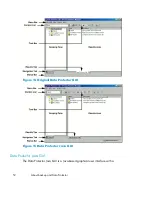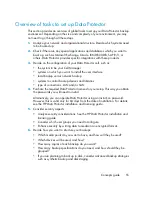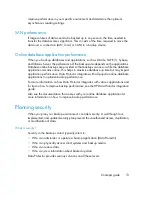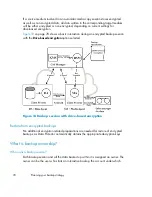
Installing and maintaining client systems
If you have several UNIX and Windows client systems, an efficient mechanism for
the installation of Data Protector becomes important. Local installation on every client
is not feasible in large environments.
Installation Servers and the Cell Manager
The main system in a Data Protector cell is the Cell Manager. To conveniently distribute
(push) Data Protector components to client systems from a central location, a system
holding the Data Protector software repository is needed. This system is called the
Data Protector Installation Server. The Cell Manager is by default also an Installation
Server.
Each time you perform a remote installation, you access the Installation Server. The
advantage of using Installation Servers is that the time required for remote installation,
update, upgrade, and removal of Data Protector software is greatly reduced,
especially in enterprise environments.
There are certain hardware and software requirements that need to be met by
Installation Servers and Cell Managers before you start installing the software. A
dedicated port, generally port 5555, needs to be available throughout the cell. For
details, see the HP Data Protector installation and licensing guide.
The Cell Manager and Installation Servers are installed directly from the CD. After
you have installed the Cell Manager and Installation Servers you can then install the
components on various client systems using the Data Protector Installation GUI.
When you install Data Protector for the first time, it runs with an instant-on license,
valid for 60 days, that lets you use Data Protector before you acquire a permanent
license. During this time, purchase any required licenses.
Also during this time, you should set up and configure your Data Protector environment
and request your permanent license. To request a permanent password string, you
need to know which client systems belong in which Data Protector cell, the number
of devices connected to the client systems, and whether you need to use any of the
Data Protector integrations.
Creating cells in the UNIX environment
Creating cells in the UNIX environment is easy. Based on the considerations given
in this manual, decide which client systems you want to add to the cell and define
the Cell Manager system. During installation, root access is required to every client
system. An important prerequisite is to have a clean node name resolving setup, such
Planning your backup strategy
64
Summary of Contents for B6960-96035
Page 17: ...Overview of backup and automated media copy sessions 340 105 Concepts guide 17 ...
Page 20: ...20 ...
Page 22: ...Publication history 22 ...
Page 132: ...Planning your backup strategy 132 ...
Page 182: ...Media management and devices 182 ...
Page 186: ...Users and user groups 186 ...
Page 204: ...The Data Protector internal database 204 ...
Page 218: ...Figure 62 Direct SIP integration example Service management 218 ...
Page 242: ...Integration with database applications 242 ...
Page 264: ...Synthetic backup 264 ...
Page 274: ...Split mirror concepts 274 ...
Page 288: ...Snapshot concepts 288 ...
Page 344: ...Further information 344 ...
Page 402: ...Glossary 402 ...






























